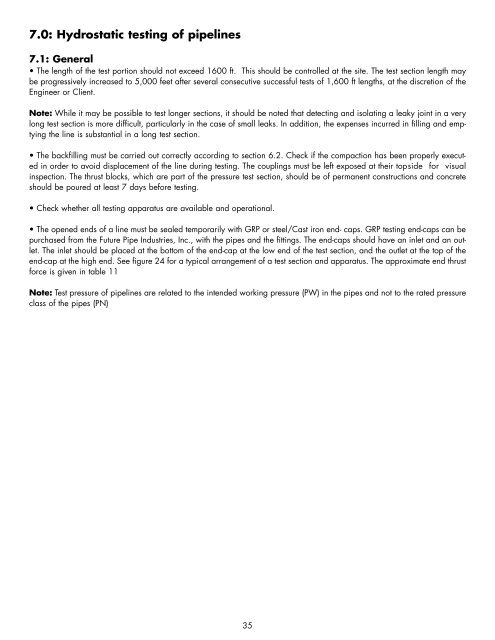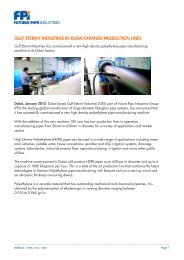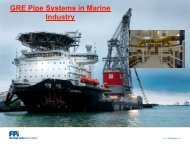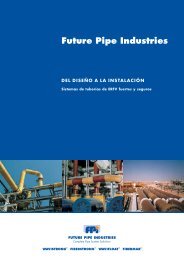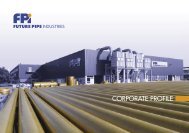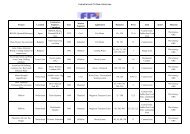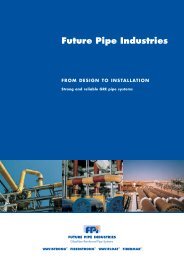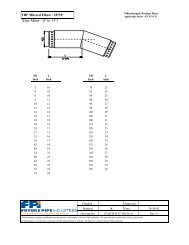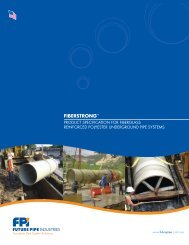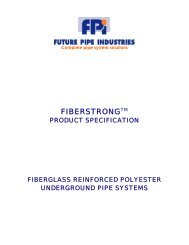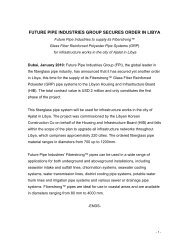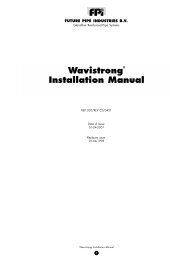7.0: Hydrostatic testing of pipelines 7.1: General • The length of the test portion should not exceed 1600 ft. This should be controlled at the site. The test section length may be progressively increased to 5,000 feet after several consecutive successful tests of 1,600 ft lengths, at the discretion of the Engineer or Client. Note: While it may be possible to test longer sections, it should be noted that detecting and isolating a leaky joint in a very long test section is more difficult, particularly in the case of small leaks. In addition, the expenses incurred in filling and emptying the line is substantial in a long test section. • The backfilling must be carried out correctly according to section 6.2. Check if the compaction has been properly executed in order to avoid displacement of the line during testing. The couplings must be left exposed at their topside for visual inspection. The thrust blocks, which are part of the pressure test section, should be of permanent constructions and concrete should be poured at least 7 days before testing. • Check whether all testing apparatus are available and operational. • The opened ends of a line must be sealed temporarily with GRP or steel/Cast iron end- caps. GRP testing end-caps can be purchased from the <strong>Future</strong> <strong>Pipe</strong> <strong>Industries</strong>, Inc., with the pipes and the fittings. The end-caps should have an inlet and an outlet. The inlet should be placed at the bottom of the end-cap at the low end of the test section, and the outlet at the top of the end-cap at the high end. See figure 24 for a typical arrangement of a test section and apparatus. The approximate end thrust force is given in table 11 Note: Test pressure of pipelines are related to the intended working pressure (PW) in the pipes and not to the rated pressure class of the pipes (PN) 35
Table 12: End thrust during pressure testing (Values are given in lbs - shaded diameter/ pressure combinations may not be availale) End thrust in lbs during pressure testing Test Press Test Press Test Press Test Press Test Press Test Press Test Press Test Press Test Press Test Press ND psi psi psi psi psi psi psi psi psi psi inch. 50 75 90 112 125 150225 265337375 3 495 742 891 1,109 1,237 1,485 2,227 2,623 3,336 3,712 4 905 1,357 1,629 1,2027 2,262 2,714 24,072 4,795 6,098 6,786 6 1,870 2,804 3,365 4,188 4,674 5,609 8,413 9,909 12,601 14,022 8 3,216 4,824 5,789 7,205 8,041 9,649 14,473 17,046 21,678 24,122 10 4,838 7,258 8,709 10,838 12,096 14,515 21,773 25,644 32,611 36,288 12 6,842 10,264 12,316 15,327 17,106 20,527 30,791 36,265 46,118 51,318 14 9,193 13,789 16,547 20,592 22,982 27,578 41,367 48,721 61,959 68,945 16 11,889 17,834 21,401 26,632 29,723 35,668 53,502 63,014 80,134 89,170 18 14,932 22,399 26,878 33,449 37,331 44,797 67,196 79,142 100,644 111,993 20 18,322 27,483 32979 41,041 45,804 54,965 82,448 91,105 123,489 137,413 24 26,140 39,209 47,051 58,553 65,349 78,419 117,628 138,540 176,181 196,047 28 33,026 49,539 59,447 73,978 82,565 99,078 148,617 175,038 222,595 247,695 30 40,212 60,319 72,382 90,076 100,531 120,637 180,956 213,125 271,031 301,593 33 45,396 68,094 81,713 101,687 113,490 136,188 204,282 240,599 305,969 340,470 36 57,605 86,407 103,688 129,034 144,011 172,814 259,221 305,304 388,255 432,034 42 77,764 116,646 139,976 174,192 194,410 233,293 349,939 412,150 524,131 583,231 48 101,341 152,012 182,415 227,005 253,354 304,024 456,036 537,109 683,041 760,061 54 130,107 195,161 234,193 291,440 325,268 390,321 585,482 689,568 876,922 975,803 60 149,012 223,518 268,221 333,787 372,530 447,036 670,554 789,763 1,004,340 1,117,589 64 169,353 254,030 304,836 379,351 423,383 508,060 762,090 897,572 1,141,441 1,270,149 72 211,915 317,872 381,447 474,689 529,787 635,745 953,617 1,123,149 1,428,306 1,589,361 78 254,289 381,433 457,720 569,607 635,722 762,867 1,144,300 1,347,732 1,713,908 1,907,167 84 293,827 440,741 528,889 658,173 734,568 881,481 1,322,222 1,557,283 1,980,394 2,203703 90 336,148 504,222 605,067 752,972 840,370 1,008,445 1,512,667 1,781,585 2,265,639 2,521,111 96 381,316 571,973 686,368 854,147 953,289 1,143,947 1,715,920 2,020,973 2,570,068 2,859,867 102 429,412 644,117 772,941 961,882 1,073,529 1,288,235 1,932,352 2,275,881 2,894,234 3,220,587 108 480,276 720,415 846,497 1,075,819 1,200,691 1,440,829 2,161,244 2,545,465 3,237,063 3,602,073 114 533,988 800,981 961,178 1,196,132 1,334,969 1,601,963 2,402,944 2,830,134 3,599,076 4,004,906 120 590,641 885,962 1,063,154 1,323,036 1,476,603 1,771,924 2,657,886 3,130,399 3,980,922 4,429,810 132 712,410 1,068,616 1,282,339 1,595,799 1,781,026 2,137,231 3,205,847 3,775,775 4,801,646 5,343,078 144 845,468 1,268,203 1,521,843 1,893,849 2,113,671 2,536,405 3,804,608 4,480,982 5,698,457 6,341,013 158 1,015,261 1,522,891 1,827,469 2,274,184 2,538,152 3,045,782 4,568,673 5,380,882 6,842,857 7,614,455 36


